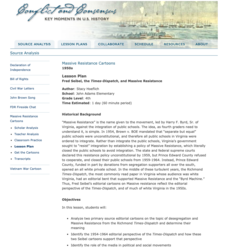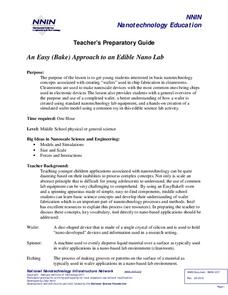Curated OER
Catapults
Students discover the catapult. In this catapult lesson, students research the history of the catapult and how it works. They work in groups to build their own catapult using tootpicks, popsicle sticks, rubber bands, and spoons.
Curated OER
Ecosystems Beneath the Surface
Sixth graders create a KWL chart about microorganisms. In this biology lesson, 6th graders create and label a diagram on a microbial mat. They investigate the processes involved in the carbon, oxygen and sulfur cycles.
Institute of Electrical and Electronics Engineers
Build Your Own Robot Arm
Learners explore design, construction, and teamwork as they design and develop robot arm at least 18 inches in length using common materials.
Curated OER
Levers, Pulleys, Incline Planes
In this pulleys, levers and incline planes worksheet, students answer 22 questions about output force, energy loss, and net force on pulleys, levers and incline planes.
Curated OER
Fire Safety in the Home
Students discover the importance of fire safety. In this fire prevention lesson plan, students identify problems in a house that could lead to a fire and draw their own homes that include the appropriate fire prevention tools. The...
Curated OER
Ship of the Line
Learners discover boats by researching 18th century ships. In this Naval history lesson plan, students identify and describe the different components of an 18th century naval ship after researching information on the Internet....
Curated OER
Up, Up and Away
Fourth graders design and launch rockets. In this rocket lesson, 4th graders observe the changes in outcome caused by size and fuel variables. Students navigate the NASA website to learn the parts of a rocket. Students load the...
Curated OER
Pet Rescue
Young scholars, in teams, follow the process of design, including the stages of investigation, creation, and reflection, as they devise a way to help "save" a (simulated) pet who is trapped in a pipe.
Virginia Department of Education
Cell Parts
What do a bird, an egg, a rabbit, and a toad all have in common? This fun-filled resource explains the similarities and differences between cells and how all cells are similar, yet all are different. Learners begin by depicting a...
Cornell University
Catapults
Ready, aim, fire! Launch to a new level of understanding as scholars build and test their own catapults. Learners explore lever design and how adjusting the fulcrum changes the outcome.
Code.org
The Need for Programming Languages
LEGO see if you can recreate my design. Individuals build an arrangement from LEGO blocks and write directions for someone else to follow in order to recreate the arrangement. Pairs then swap directions and try to...
Inside Mathematics
Quadratic (2009)
Functions require an input in order to get an output, which explains why the answer always has at least two parts. After only three multi-part questions, the teacher can analyze pupils' strengths and weaknesses when it comes to...
Teach Engineering
Induced EMF in a Coil Wire
Small groups investigate the interaction between a coil of wire and a magnet to create an electromagnetic field and observe the voltage they create. Through further interactions, they realize a conductor can be charged from the...
Teach Engineering
Strong-Arm Tactics
Experience collecting rock samples using a robotic arm with an activity that has pairs work together to operate a robotic arm. One pupil serves as the eyes and the other operates the controller. The objective is to be the fastest pair to...
Curated OER
A Math Board Game
Math is fun with a board game printable set. After printing the pieces and board for the game, have your kids play in groups to practice concepts such as operations and arithmetic formulas.
Practical Action
The Wind Power Challenge
Up it goes! Groups must design and build a windmill able to lift a weight. The packet includes discussion points to use prior to the build that cover topics such as variables, fairness, and the design process.
Teach Engineering
Projectile Magic
What do the movies October Key and Harry Potter and the Sorcerer's Stone have in common? The fourth installment of a five-part module presents equations regarding projectile motion and how to rearrange them. Scholars view video clips...
Teach Engineering
Magical Motion
Make solutions to projectile motion problems magically appear using equations. Pupils watch a clip from a Harry Potter movie and find the length of time it takes for a remembrall to fall into Harry's hands. They use a projectile motion...
Roy Rosenzweig Center for History and New Media
Fred Seibel, the Times-Dispatch, and Massive Resistance
A lesson challenges scholars to analyze editorial cartoons created by Fred Seibel, illustrator for the Times-Dispatch, during the Massive Resistance. A class discussion looking at today's editorial pages and Jim Crow Laws leads the...
Illustrative Mathematics
The Escalator, Assessment Variation
A great way to practice with unit rates, the activity gives your mathematicians an opportunity to compare different statements and select which are true. They can practice with "choose all that apply" by setting each statement into its...
Illustrative Mathematics
Riding at a Constant Speed, Assessment Variation
Practice ratios and unit rates with tracking how long Lin took to ride her bike. Provided with different questions, your mathematicians can assemble their answers using a chart or setting up ratios. The activity is included in a set of...
Illustrative Mathematics
Molly's Run, Assessment Variation
Part of as assessment series, the activity follows the lesson Molly's Run to practice ratios and dividing with fractions. Different solution options are given for your learners' preference. The commentary explains how the...
NASA
What's the Frequency, Roy G. Biv?
While all light travels at the same speed, each color in the visible light spectrum contains a different wavelength and frequency. Scholars determine the relationship between frequency and wavelength as they complete the activity. They...
National Nanotechnology Infrastructure Network
An Easy (Bake) Approach to an Edible NanoLab
You can make it if you bake it! Young scientists model electronic chip fabrication with an easy bake oven. They create a design to embed in their brownie "chips" and compare their models to wafer production in basic nanotechnology.
Other popular searches
- Simple Machines Crossword
- Simple Machines Worksheet
- Lego Simple Machines
- Six Simple Machines
- Building Simple Machines
- Levers Simple Machines
- Simple Machines Art
- Simple Machines Lesson Plans
- Math Simple Machines
- Simple Machines Pulleys
- Work and Simple Machines
- Pulley Lego Simple Machines























